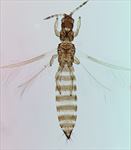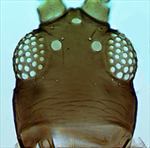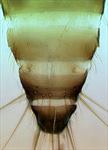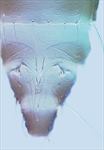
Female

Head & thoracic tergites

Female antenna

Head

Tergites VII–X

Sternites VII & ovipositor

Male sternites III–IV

Male & female

Male head and antenna

Fore wing
Both sexes fully winged. Body typically bicolored, head and thorax brown, abdomen paler but apex dark; legs yellow, also antennal segments III–IV; fore wings light brown, basal quarter pale. Antennae 7-segmented; segment IV longer than III, apex constricted into a neck, both segments with forked sense cone; segment I with a pair of small setae dorsally at extreme apex. Head longer than wide, projecting in front of eyes; two pairs of ocellar setae present, pair III just in front of hind ocelli, about as long as side of ocellar triangle. Pronotum with two pairs of long posteroangular setae. Metanotum with little or no sculpture medially; median setae small, arising well behind anterior margin; campaniform sensilla absent. Fore wing first vein with six basal setae, then two setae near apex, second vein with about 10 setae. Abdominal tergites without sculpture medially; ctenidia not present, except rudimentary ctenidia sometimes present on tergites VI–VII; tergite VIII posteromarginal comb represented by a few small microtrichia laterally; ovipositor valves very weak, not serrate. Sternites without discal setae.
Male smaller than female; antennal segment III very small, IV–VI each with several rings of long setae, VII very small; abdominal tergite IX posterior margin with two stout thorn-like setae each arising from prominent tubercle; sternites III–IV each with two small circular pore plates laterally.
Seventeen species are currently listed in the genus Plesiothrips, of which six are known from North America (but only one from California), and the others from Central and South America (Mound et al., 2016).
Developing within the florets of various Poaceae including sugar cane, but with no recorded specificity.
Probably originating in southeastern USA, this species is widespread in eastern USA, and recorded from California, Texas and Mexico, as well as from various tropical and subtropical parts of the world, including the Galapagos Islands, and also eastern Australia.
THRIPIDAE - THRIPINAE
Plesiothrips perplexus (Beach)
Sericothrips perplexus Beach, 1896: 216
Thrips panicus Moulton, 1929: 61.
Mound L, Lima E, O'Donnell C & Cavalleri A (2016) New World grass thrips of the genus Plesiothrips (Thysanoptera: Thripidae). Austral Entomology 55: 340–346.